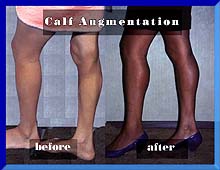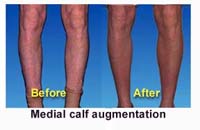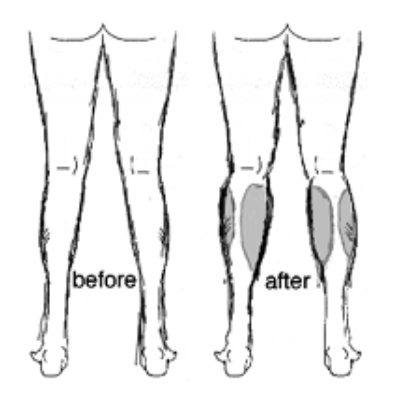 Calf implant surgery is a popular option at the Facial Plastic & Cosmetic Surgical Center. Originally introduced for male body builders, who were unable to develop satisfactory calf size and definition, the operation has now become even more popular for women. While usually carried out for equal enlargement of both calves in patients who are seeking cosmetic enhancement, special applications exists for individuals who have atrophy of one leg as a result of polio or similar injuries.
Calf implant surgery is a popular option at the Facial Plastic & Cosmetic Surgical Center. Originally introduced for male body builders, who were unable to develop satisfactory calf size and definition, the operation has now become even more popular for women. While usually carried out for equal enlargement of both calves in patients who are seeking cosmetic enhancement, special applications exists for individuals who have atrophy of one leg as a result of polio or similar injuries.
 Surgery involves the placement of specially designed soft silicone implants through short incisions made behind the knee. The technique is individualized, depending on the needs or desires of the individual patient. In most cases, a single implant is placed in each leg, augmenting the medial surface of the leg. In rare cases, two implants are used in each leg, placing one towards the middle and the other towards the outside. The implants are available in several sizes and shapes.
Surgery involves the placement of specially designed soft silicone implants through short incisions made behind the knee. The technique is individualized, depending on the needs or desires of the individual patient. In most cases, a single implant is placed in each leg, augmenting the medial surface of the leg. In rare cases, two implants are used in each leg, placing one towards the middle and the other towards the outside. The implants are available in several sizes and shapes.
The implants are made of a soft but solid type of silicone, as distinguished from the gel filled silicone implant used in breast augmentation. This avoids any possible risks of rupture or extrusion of silicone into the soft tissue of the leg.
 The surgery, while normally carried out under general anesthesia, can be performed under local anesthesia if the patient so desires. It generally takes about an hour. Patients wear elastic support hose for a few weeks after surgery, but no other dressings are required. Sutures are removed about ten days after the operation. The scar behind the knee, while quite visible at first, usually fades within a year.
The surgery, while normally carried out under general anesthesia, can be performed under local anesthesia if the patient so desires. It generally takes about an hour. Patients wear elastic support hose for a few weeks after surgery, but no other dressings are required. Sutures are removed about ten days after the operation. The scar behind the knee, while quite visible at first, usually fades within a year.
Complications, in addition to the usual risks such as bleeding or infection, include the possibility of shifting or displacement of the implant. Fortunately, this has proven to be unusual, especially when surgery is limited to a single implant in each leg. Because of the higher risk of displacement when two implants are placed on either side, this procedure is reserved for unusual situations.
There may be considerable discomfort following the operation, which lasts for several days, but is usually adequately relieved by wearing elevated heels. Even men find that elevating the heel of their shoe will ease the pain during the early postoperative period.
Interest in calf augmentation has increased as patients continue to learn about this surgical possibility. Since few surgeons are experienced in the techniques, patients frequently come to our Center from great distance to undergo the surgery. Our experience with this operation has been very positive and our many happy patients attest to its value. •

